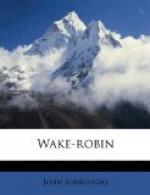This bird was unknown to the older ornithologists, and is but poorly described by the new. It builds a mossy nest on the ground, or under the edge of a decayed log. A correspondent writes me that he has found it breeding on the mountains in Pennsylvania. The large-billed water-thrush is much the superior songster, but the present species has a very bright and cheerful strain. The specimen I saw, contrary to the habits of the family, kept in the treetops like a warbler, and seemed to be engaged in catching insects.
The birds were unusually plentiful and noisy about the head of this lake; robins, blue jays, and woodpeckers greeted me with their familiar notes. The blue jays found an owl or some wild animal a short distance above me, and, as is their custom on such occasions, proclaimed it at the top of their voices, and kept on till the darkness began to gather in the woods.
I also heard, as I had at two or three other points in the course of the day, the peculiar, resonant hammering of some species of woodpecker upon the hard, dry limbs. It was unlike any sound of the kind I had ever heard, and, repeated at intervals through the silent wood, was a very marked and characteristic feature. Its peculiarity was the ordered succession of the raps, which gave it the character of a premeditated performance. There were first three strokes following each other rapidly, then two much louder ones with longer intervals between them. I heard the drumming here, and the next day at sunset at Furlow Lake, the source of Dry Brook, and in no instance was the order varied. There was a melody in it, such as a woodpecker knows how to evoke from a smooth, dry branch. It suggested something quite as pleasing as the liveliest bird-song, and was if anything more woodsy and wild. As the yellow-bellied woodpecker was the most abundant species in these woods, I attributed it to him. It is the one sound that still links itself with those scenes in my mind.
At sunset the grouse began to drum in all parts of the woods about the lake. I could hear five at one time, thump, thump, thump, thump, thr-r-r-r-r-r-rr. It was a homely, welcome sound. As I returned to camp at twilight, along the shore of the lake, the frogs also were in full chorus. The older ones ripped out their responses to each other with terrific force and volume. I know of no other animal capable of giving forth so much sound, in proportion to its size, as a frog. Some of these seemed to bellow as loud as a two-year-old bull. They were of immense size, and very abundant. No frog-eater had ever been there. Near the shore we felled a tree which reached far out in the lake. Upon the trunk and branches, the frogs soon collected in large numbers, and gamboled and splashed about the half submerged top, like a parcel of schoolboys, making nearly as much noise.
After dark, as I was frying the fish, a panful of the largest trout was accidently capsized in the fire. With rueful countenances we contemplated the irreparable loss our commissariat had sustained by this mishap; but remembering there was virtue in ashes, we poked the half-consumed fish from the bed of coals and ate them, and they were good.




